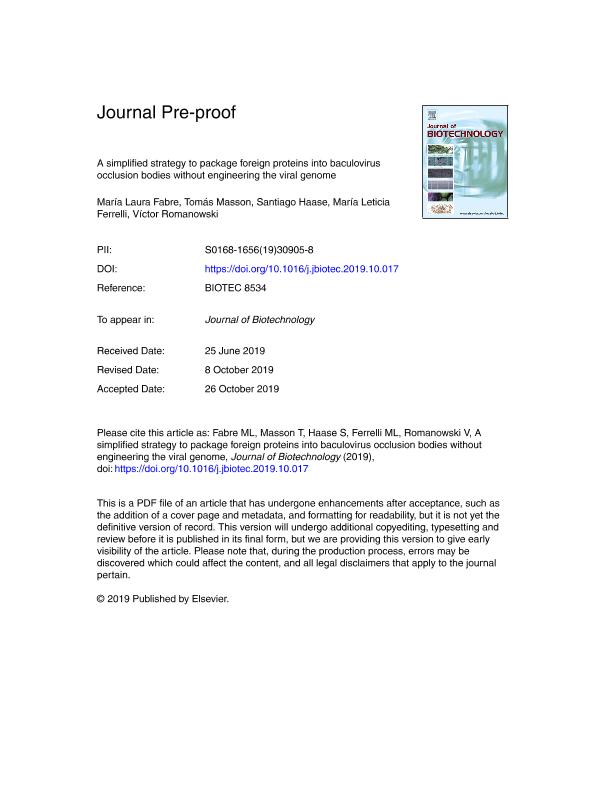Artículo
A simplified strategy to package foreign proteins into baculovirus occlusion bodies without engineering the viral genome
Fecha de publicación:
10/01/2020
Editorial:
Elsevier Science
Revista:
Journal of Biotechnology
ISSN:
0168-1656
Idioma:
Inglés
Tipo de recurso:
Artículo publicado
Clasificación temática:
Resumen
Polyhedron envelope protein (PEP) is the major component of the calyx that surrounds the baculovirus occlusion body (OB). PEP has been associated with the stabilization and resistance of polyhedra in the environment. Due to the abundant levels of PEP in OBs, we decided to use this protein as a fusion partner to redirect foreign proteins to baculovirus polyhedra. In this study we developed a strategy that involves the generation of a monoclonal transformed insect cell line expressing a protein of interest fused to the the Anticarsia gemmatalis multiple nucleopolyhedrovirus (AgMNPV) N-terminus of PEP that enables the packaging of foreign proteins into the OBs without generating a recombinant baculovirus. This proved to be an efficient platform that could be exploited to improve wild type baculovirus for their use as bioinsecticides without facing the concerns of releasing genetically modified DNA to the environment and bypassing the associated regulatory issues. We demonstrated, using immunological, proteomic and microscopy techniques, that the envelope of AgMNPV OBs can effectively trap chimeric proteins in an infected insect cell line expressing AgMNPV PEP fused to the enhanced green fluorescent protein (eGFP). Furthermore, packaging of chimeric PEP also took place with heterologous OBs such as those of Autographa californica multiple nucleopolyhedrovirus (AcMNPV), another group I alphabaculovirus.
Palabras clave:
ACMNPV
,
AGMNPV
,
POLYHEDRON ENVELOPE PROTEIN (PEP)
,
UFLAG-286
Archivos asociados
Licencia
Identificadores
Colecciones
Articulos(IBBM)
Articulos de INST.DE BIOTECNOLOGIA Y BIOLOGIA MOLECULAR
Articulos de INST.DE BIOTECNOLOGIA Y BIOLOGIA MOLECULAR
Citación
Fabre, Maria Laura; Masson, Tomas; Haase, Santiago; Ferrelli, Maria Leticia; Romanowski, Victor; A simplified strategy to package foreign proteins into baculovirus occlusion bodies without engineering the viral genome; Elsevier Science; Journal of Biotechnology; 307; 10-1-2020; 175-181
Compartir
Altmétricas




